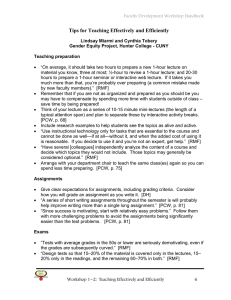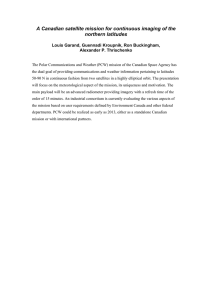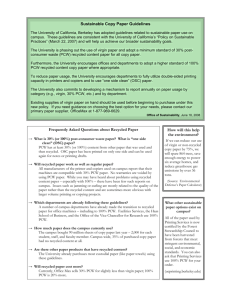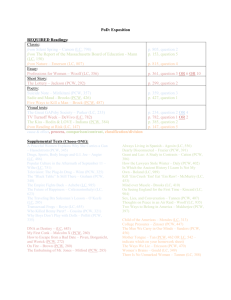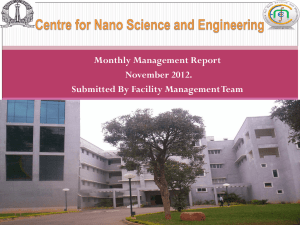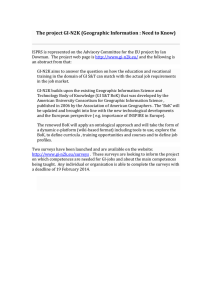1 Tips for Teaching Effectively and Efficiently Lindsay Miarmi
advertisement
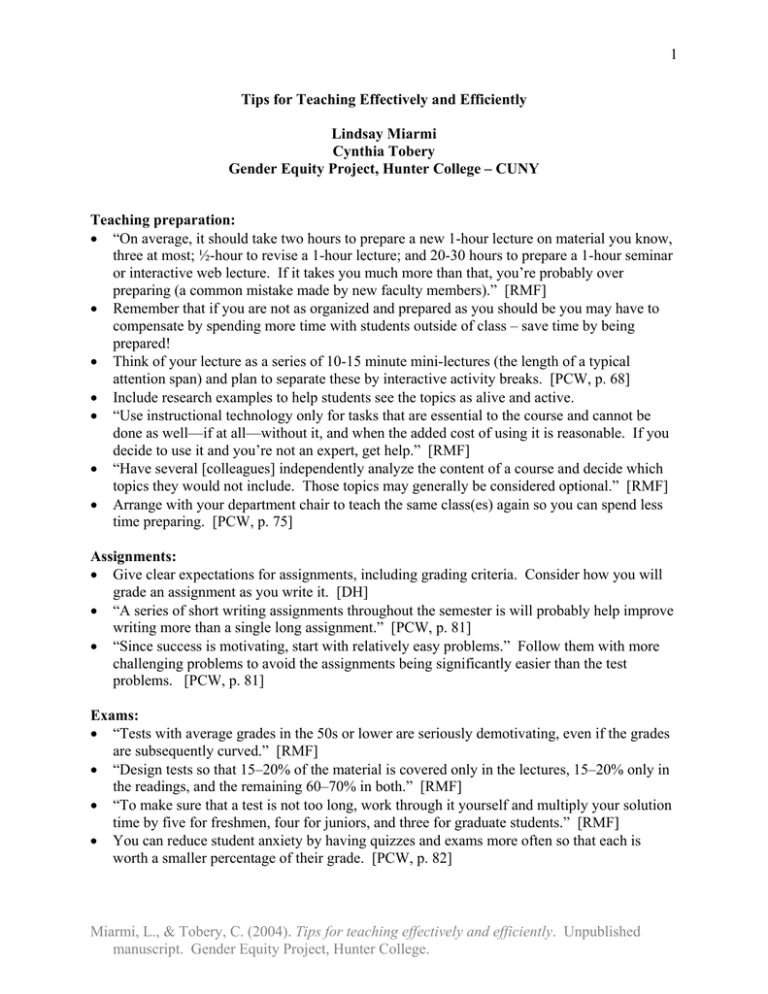
1 Tips for Teaching Effectively and Efficiently Lindsay Miarmi Cynthia Tobery Gender Equity Project, Hunter College – CUNY Teaching preparation: • “On average, it should take two hours to prepare a new 1-hour lecture on material you know, three at most; ½-hour to revise a 1-hour lecture; and 20-30 hours to prepare a 1-hour seminar or interactive web lecture. If it takes you much more than that, you’re probably over preparing (a common mistake made by new faculty members).” [RMF] • Remember that if you are not as organized and prepared as you should be you may have to compensate by spending more time with students outside of class – save time by being prepared! • Think of your lecture as a series of 10-15 minute mini-lectures (the length of a typical attention span) and plan to separate these by interactive activity breaks. [PCW, p. 68] • Include research examples to help students see the topics as alive and active. • “Use instructional technology only for tasks that are essential to the course and cannot be done as well—if at all—without it, and when the added cost of using it is reasonable. If you decide to use it and you’re not an expert, get help.” [RMF] • “Have several [colleagues] independently analyze the content of a course and decide which topics they would not include. Those topics may generally be considered optional.” [RMF] • Arrange with your department chair to teach the same class(es) again so you can spend less time preparing. [PCW, p. 75] Assignments: • Give clear expectations for assignments, including grading criteria. Consider how you will grade an assignment as you write it. [DH] • “A series of short writing assignments throughout the semester is will probably help improve writing more than a single long assignment.” [PCW, p. 81] • “Since success is motivating, start with relatively easy problems.” Follow them with more challenging problems to avoid the assignments being significantly easier than the test problems. [PCW, p. 81] Exams: • “Tests with average grades in the 50s or lower are seriously demotivating, even if the grades are subsequently curved.” [RMF] • “Design tests so that 15–20% of the material is covered only in the lectures, 15–20% only in the readings, and the remaining 60–70% in both.” [RMF] • “To make sure that a test is not too long, work through it yourself and multiply your solution time by five for freshmen, four for juniors, and three for graduate students.” [RMF] • You can reduce student anxiety by having quizzes and exams more often so that each is worth a smaller percentage of their grade. [PCW, p. 82] Miarmi, L., & Tobery, C. (2004). Tips for teaching effectively and efficiently. Unpublished manuscript. Gender Equity Project, Hunter College. 2 • • In a medium-sized undergraduate class, exams should have a broad range of scores. If there are no grades in the 90s the exam was either too long or too hard (or both); if there are no scores below 50, the test may have been too easy. [PCW, p. 85] Old exams can be given as practice tests or ungraded assignments. [PCW, p. 84] Grading and feedback: • Don’t spend time correcting grammatical mistakes - suggest that students use the writing center. • “Develop a response rubric, that is, a list of elements of the paper, with values you can check off. Typical broad criteria include: focus, thesis, argument; organization; clarity of development; quality and quantity of evidence or support; ambition (degree of difficulty); format; correctness; and style. However, each element may look different in different situations. Use general rubrics to develop ones tailored to specific assignments.” [DH] • “Set ground rules for yourself, and clearly convey to students what they can and cannot expect in terms of your response. For example, tell them (or include a response sheet that tells them) that your written comments will address only one main strength and one main area for improvement, if that's what you choose to do. Cover other aspects of the paper with a response or grading rubric.” [DH] • “Use brief marginal comments to call attention to "higher order" aspects in the paper, usually content or development. A "good" or a "yes" or a "?" or an "evidence?" go a long way. Use squiggly lines (or what you will) to call attention to sentence errors or hugely rough spots (but remember that your goal should be to teach). Don't feel compelled to mark everything, and certainly don't edit everything.” [DH] • Consider responding only in a summary paragraph that addresses the main criteria of the assignment overall (content, organization, originality, use of course material, etc.). Start by telling them what they did well. • “Marking every error is not only time-consuming, but it also may not be that helpful for students, especially if you do not plan for them to revise the assignment for resubmission. They may find it difficult to distinguish between minor mistakes in grammar and major flaws in reasoning, and may be generally demoralized. On the other hand, students need a clear idea of areas requiring improvement. One tactic is to compose a paragraph about each student's work that addresses areas of strength and weakness based on the grading criteria. These remarks may be structured much as a professional reviewer's comments on a manuscript. By typing these comments in a word processing file, you can save them as part of your record of students' work and use them to follow their progress.” [MC] • Keep your grading policy consistent, no matter what guidelines you set. [PCW, p. 90] In the classroom: • Learn names! o Make sure you ask for the correct pronunciation of students’ names and call them by name. [PCW, p. 125] o Have a few students introduce themselves to the class at every session until the entire class has been introduced. [PCW, p. 126] • “If you want students to talk, look at them… Asking students to speak in class is easier to do if they use name cards or if you have learned their names. This will encourage them to use each others' names as well; people are more likely to talk when they know each other.” [Bok] Miarmi, L., & Tobery, C. (2004). Tips for teaching effectively and efficiently. Unpublished manuscript. Gender Equity Project, Hunter College. 3 • • • • • • • • • • • “Create flexible learning processes that account for the variety of learning styles that may exist in a diverse classroom.” [Bok2] “Examine how your own experiences, values, beliefs, and stereotypes inform the way you interact with individuals whose racial backgrounds are different from your own.” [Bok2] Sometimes diverse classrooms with diverse views lead to hot moments in the classroom: o “Defuse potentially harmful moments by having students step back and reflect on the situation.” [Bok2] o “Turn potentially hot moments into powerful learning experiences by turning the questions they raise back to the group for discussion.” [Bok2] “Encourage [students] who seem to be at a disadvantage by virtue of culture or training: who expect to be interrupted, doubt their own authority or frame their comments as questions. But be ready to credit intelligent observation and engaged listening among them as a distinctive kind of participation.” [Bok3] At the start of each class, present an outline of what you will cover and refer back to this throughout the lecture. Have students turn in short assignments at the beginning of class or give quizzes to encourage the students to be prepared for your class. [PCW, p. 43] “When a student asks a question, instead of answering yourself, ask for an answer from other members of the class. In a large group, always repeat a question or paraphrase a response before going on, so that all students can hear and understand (this is especially important when students in the class do not speak English as a native language).” [Bok] “Pause in the lecture after making a major point. Show students a multiple-choice question based on the material you have been talking about. (Example: "If the incidence rate of tuberculosis (TB) increased due to an increase in immunocompromised AIDS patients, but the duration of tuberculosis infections remained the same, the prevalence of TB would a) increase, b) decrease, or c) not change.") Ask students to vote on the right answer, and then turn to their neighbors to persuade them of the answer within the space of two minutes (talking to a few people is easier than speaking up in a large group). When time is up, ask them to vote a second time. Usually far more students arrive at the correct answer when voting the second time.” [Bok] “Resist filling every uncomfortable pause with your own voice.” [Bok3] “Do a one-minute paper at the end of class. In this exercise, students write down what they consider (a) the main point of the class and (b) the main question they still have as they leave. You can use some of these questions to begin the next lecture, or students can be asked to bring them to section or lab. One advantage of this technique is that students may listen more carefully and review their notes thoughtfully.” [Bok] Assign tasks that encourage active involvement from students, such as cooperative groups, role plays, debates, etc. [PCW, 42] “Help the students learn how to interact to achieve the purpose of the group.” [PCW, 95] Office hours and communicating with students: • “If your schedule permits, come early to lecture or stay late to answer questions and engage in discussion with students. If you are available five or ten minutes before and after class, some students will talk with you more readily, and you will get to know them and their thoughts.” [Bok] Miarmi, L., & Tobery, C. (2004). Tips for teaching effectively and efficiently. Unpublished manuscript. Gender Equity Project, Hunter College. 4 • • • • • • “Come out from behind the desk, keep candy on hand, and consider requiring every student to come in once early in the semester.” [RMF] Practice active listening skills and direct all your attention to the student when/if they come to see you. [PCW, p. 141] Always be respectful of student confidentiality. [PCW, p. 140] Have a set time for office hours and try to schedule it between meetings or at another time that you probably will not get much research done. You may want to have an open door policy for your graduate students but have set hours for undergraduates. Realize you will need to close your door to get work done! “Use Blackboard to spark debate. Ask students to post comments and replies to a web-based discussion board; make specific reference to those exchanges in lecture.” [MC2] References [Bok] Tips for teachers: Twenty ways to make lectures more participatory. (1994) Retrieved September 29, 2004, from Harvard University, Derek Bok Center for Teaching and Learning Web site: http://bokcenter.harvard.edu/docs/TFTlectures.html [Bok2] Teaching in racially diverse college classrooms: Executive summary. (n.d.) Retrieved September 29, 2004, from Harvard University, Derek Bok Center for Teaching and Learning Web site: http://bokcenter.harvard.edu/docs/TFTrace-summary.html [Bok3] Sensitivity to women in the contemporary classroom. (n.d.) Retrieved September 29, 2004, from Harvard University, Derek Bok Center for Teaching and Learning Web site: http://bokcenter.harvard.edu/docs/TFTwomen.html [MC] Evaluating student work. (2003) Retrieved September 27, 2004, from Princeton University, McGraw Center for Teaching and Learning Web site: http://web.princeton.edu/sites/mcgraw/mcgraw_minigraphs_01.html [MC2] Engaging a large lecture class. (2003) Retrieved September 27, 2004, from Princeton University, McGraw Center for Teaching and Learning Web site: http://web.princeton.edu/sites/mcgraw/mcgraw_minigraphs_06.html [DH] Hesse, D. (n.d.) Efficiently Grading Student Writing. Retrieved June 30, 2004, from Illinois State University, Center for the Advancement of Teaching Web site: http://www.cat.ilstu.edu/publications/supplement/grading.shtml [RMF] Felder, R. M. (2002). The effective, efficient professor [Electronic version]. Chemical Engineering Education, 36(2), 114-115. (Review of Wankat’s book) http://www.ncsu.edu/felder-public/Columns/Wankat.html [PCW] Wankat, P. C. (2002). The effective, efficient professor: teaching, scholarship, and service. Boston : Allyn and Bacon. Miarmi, L., & Tobery, C. (2004). Tips for teaching effectively and efficiently. Unpublished manuscript. Gender Equity Project, Hunter College.
